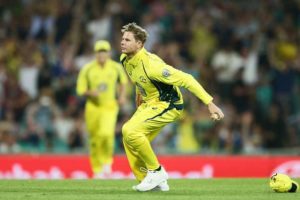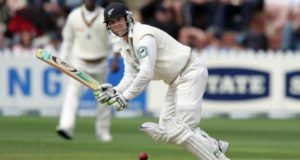
Steve Smith had the sort of day that all cricketers dream of. From the moment he won the toss and elected to bat it was his day. Smith scored 164 out of Australia’s total of 324/8, then he took a flying screamer of a catch to dismiss BJ Watling and Australia won by 68 runs.
New Zealand won the first session, with movement on the grassy Sydney Cricket Ground pitch inducing both Australian openers to chop on. They were in an excellent position at the fall of the fourth wicket, which came when a solid straight drive from Smith went through the hands of Jimmy Neesham and ran Mitchell Marsh out at the non-striker’s end. At that point Australia were 92/4 and it felt that only Smith stood between competitiveness and disaster.
He then embarked upon a 127-run stand with Travis Head, who was fortuitously dropped by Matt Henry at mid off early in his innings. When Head was brilliantly caught and bowled by Trent Boult, Matthew Wade joined him at the crease, and the two went on the counterattack.
They scored 83 runs in 6.1 overs, and even a flurry of wickets at the end couldn’t stop them from posting a very strong total, in this case 324/8.
Australia won the early session much like New Zealand had, accounting for Tom Latham and Kane Williamson for single-digit scores. Jimmy Neesham came in at 4 in place of Ross Taylor, and was able to hit through the line well, scoring 34 off 36.
Perhaps the decisive act in the match came again from Smith, only this time in the field. A short and wide ball from Marsh to BJ Watling was dispatched, but Smith threw himself to his left and caught the ball at full stretch on his thumb, taking a face plant into the SCG turf so as to not spill the ball.
From there it was up to Guptill, and while he and Munro put on a brisk 45 Guptill was dismissed against the run of play, slapping an Adam Zampa long hop to Glenn Maxwell at midwicket. Guptill had scored 114 from 102 balls and looked set for another titanic innings, timing almost everything out of the very middle, before the dismissal.
At that point New Zealand still needed 140 runs in 17 overs with 5 wickets in hand, but the run rate was accelerating out of range of their hitting power.
Colin Munro and Matt Henry gave the Black Caps some late hope, getting them to within 72 runs before Henry was deceived by a clever Pat Cummins slower ball, which he skied to George Bailey for 27 off 15. When Munro was next out in a very similar fashion for 49 off 59 the Black Caps were unable to offer further resistance and were dismissed for 256.
Despite the loss, New Zealand will take heart from the performance, and may be regretting the decision to not review an lbw shout on Smith when he was on 13. Replays showed the decision would have been overturned and from there it would have been a very different match.
In the end, the catching skill of Australia was probably the decisive factor, as a Watling-Guptill partnership at that time of the match might have brought the Black Caps very close to a win.
The series continues in Canberra on Tuesday.



